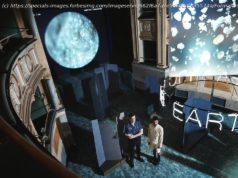His pictures, often subtle and reflective, captured the era of apartheid and beyond.
David Goldblatt, a photographer who for more than 50 years documented with a cool fury the oppressive racial dynamics of his native South Africa during apartheid and after, died on Monday at his home in Johannesburg. He was 87.
The cause was cancer, said Peter MacGill of the Pace/MacGill Gallery in New York, which represents him.
Mr. Goldblatt, whose pictures were published in numerous books and displayed in countless gallery shows, captured the daily lives of white and black South Africans during tumultuous times. But he was not the kind of photographer who was often found in the middle of violent confrontations.
“I’m a coward; I run away from violence,” he told the photography site ASX in 2013. “I’m not interested in events as such as a photographer. As a citizen of the country, yes, of course I am. But as a photographer, I am interested in the causes of events.”
Thus his subjects included a man watering his lawn, a woman and child lying on a mattress, an abandoned housing development. He made powerful images of people, but also evocative ones of objects or landscapes. One showed a bleak cemetery for white members of a security force who were killed in a clash in Transvaal.
“This place was clearly supposed to honor the whites who fell fighting for apartheid; it is, after all, called ‘The Heroes’ Acre,’ ” Sarah Boxer wrote in The New York Times, reviewing a 1998 exhibition in which the photograph appeared. “But because it resembles a concentration camp gate, it slyly suggests that the fences of apartheid were doubly oppressive, not only keeping blacks out but also shutting whites in.”
David Goldblatt was born on Nov. 29,1930, in Randfontein, a small mining town west of Johannesburg. His parents, Eli and Olga (Light) Goldblatt, had been brought to South Africa as children from their native Lithuania as their parents sought refuge from persecution of Jews there.
His father ran a clothing store, and his mother worked as a typist for a clothing company, which, David speculated, may have been how they met. David began taking photographs when he was a teenager, at a time when image-centered magazines like Life were raising photography’s visibility.
His older brother, Dan, who served in World War II, had brought a damaged German camera, a Contax, home with him, and their father bought it from Dan and gave it to young David. The result, though, was not instantaneous improvement.
“I tried to generate some primitive photo essays and failed,” Mr. Goldblatt told frieze.com last year. “I was very ill equipped, not just mechanically, but in the beginning I had no sense of how photographs work together.”
He set about getting some instruction, at first from a wedding photographer who assigned him a dubious task. “He would drape several cameras around my neck so that I looked very professional, and my job was to ensure that no guest with a good camera got a good picture,” he recalled in an interview with South African History Online . “I would have to bump or walk in front of them at the critical moment so that my boss was the only person who ended up with good photographs.”
He earned a degree in commerce from the University of Witwatersrand in Johannesburg, and when his father died in 1962, he took over his clothing shop. He sold it in 1963 and used the proceeds to become a photographer.
“I knew I needed something in my life that was related to the smell and the touch and the sense of reality,” he explained. “There was a great seductive quality about economics, but it was essentially abstract. Somehow I knew photography would be it.”
Mr. Goldblatt lined up corporate clients, but he also began taking pictures of a different sort. One subject that fascinated him was the country’s dying gold mining industry. The result was “On the Mines” (1973), his first book, a collaboration with the South African writer Nadine Gordimer.
Among his other books was “The Transported of KwaNdebele” (1989), which documented the oppressively long commutes of blacks living in segregated “homelands” to jobs in urban centers. For a series of photographs he called “Ex-Offenders at the Scene of the Crime,” he took former convicts back to the spots where the crimes they were convicted of had occurred.
Mr. Goldblatt shot mostly in black-and-white for much of his career. In 1998 the Museum of Modern Art in New York gave him a solo exhibition. Its 40 photographs were all black-and-white because, he explained, “color seemed too sweet a medium to express the anger, disgust and fear that apartheid inspired.”
But in the 1990s he began working in color, adapting to the digital age.
“I’ve found the venture into color quite exciting,” he said in 2011, “largely because new technology has enabled me to work with color on the computer as I have done with black and white in the darkroom.”
The Yale University Art Gallery recently acquired hundreds of Mr. Goldblatt’s photographs and supporting archival material.
Mr. Goldblatt is survived by his wife, Lily (Psek) Goldblatt, whom he married in 1955; his children, Steven, Brenda and Ronnie; and two grandchildren.
Last year, in advance of a retrospective that opened in February at the Pompidou Center in Paris, he was asked about his recent work. He cited an image of a pedestrian bridge across a rail line in a village called Leeu-Gamka. The photograph shows two wide stairways — an odd remnant of the time when society was so divided that there were separate stairs for blacks and whites.
“Why have a footbridge in a tiny hamlet of no more than 2,000 people and build it with two lanes wide enough to accommodate rush hour on a London tube?” he said. “It’s beyond madness. The apartheid signs have gone, but the two-lane stairs remain.”






